Everything You Need to Know About Demand Generation: Strategies, Tactics, and Examples
 Demand doesn’t generate itself.
If it did, we’d all be able to pack up our stuff and find a different career.
Our organizations would blissfully carry on without us, bringing in leads
Fortunately for us, that isn’t the way things work, and thus we remain gainfully employed.
Somewhat less fortunately, it turns out drumming up business with content is easier said than done. It takes a strong understanding of your audience, smart strategy, and consistent execution to make that happen.
In other words, it isn’t work you’re going to finish in a weekend. It’s going to take time, commitment, and a little bit of know-how.
That’s where this post comes in. Here, you’ll find:
Demand doesn’t generate itself.
If it did, we’d all be able to pack up our stuff and find a different career.
Our organizations would blissfully carry on without us, bringing in leads
Fortunately for us, that isn’t the way things work, and thus we remain gainfully employed.
Somewhat less fortunately, it turns out drumming up business with content is easier said than done. It takes a strong understanding of your audience, smart strategy, and consistent execution to make that happen.
In other words, it isn’t work you’re going to finish in a weekend. It’s going to take time, commitment, and a little bit of know-how.
That’s where this post comes in. Here, you’ll find:
- Clarity around what demand generation is (and is not). It’s a somewhat confusing concept due to the amount of overlap between it and other marketing disciplines.
- An outline for how to plan a demand gen strategy. Get templates and guidance you need to start putting a plan into practice.
- Links to actionable blog posts and other reliable sources. Check the Recommended Reading callouts throughout the post for more detailed guides on how to implement each piece of your strategy. This is a broad topic, and condensing down everything about it into one post isn’t entirely possible. But, you can consider this your one bookmarkable hub to find all the resources you’ll need in one place.
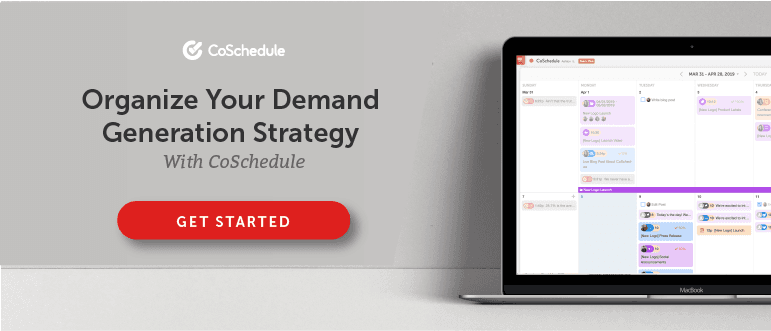
What Exactly is Demand Generation?
This genuinely isn’t a dumb question. Demand generation, as a marketing term, describes a broad set of practices and tactics that are all centered around one thing: making people care about your product. It encompasses everything an organization does to raise awareness and build interest in what they sell. That can include branding, public relations, content marketing, or anything else that helps turn audiences from not knowing you exist, to wondering why they didn’t buy sooner.
How Does That Differ From Lead Generation?
You’ve probably heard the term lead generation too, and might be wondering how it differs from demand gen. Solomon Thimothy from Clickx sums up the distinction between the two well in this video:What's the difference between #LeadGeneration and #DemandGeneration?
Click To Tweet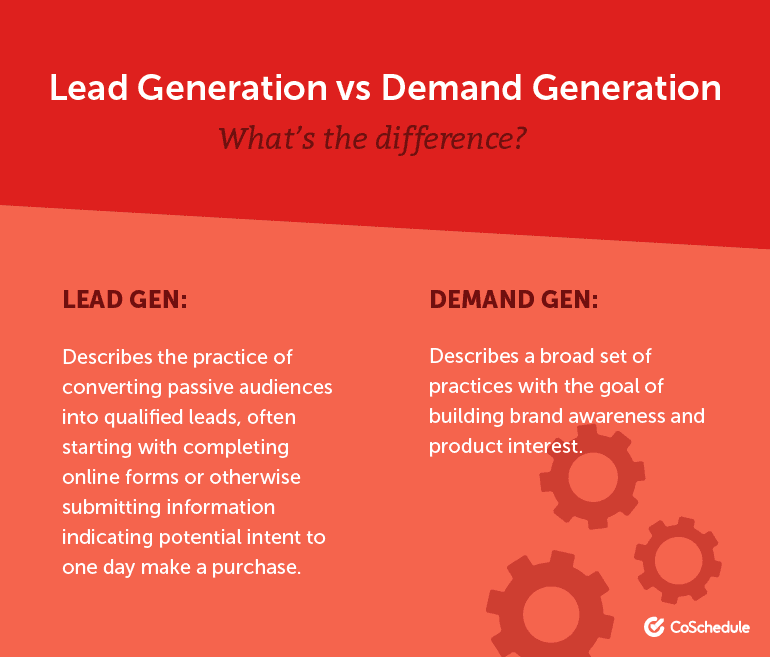
Understanding Why Demand Generation Matters
No one cares about your brand. At least, not until they realize they have a problem that needs solving, or they discover a want for a particular type of product or service. But, even then, once their search for a solution begins, you have plenty of competitors they could find instead. So, it’s up to you to build interest in your industry, get in front of potential customers, and deliver the kind of value that’s going to attract people to you (instead of any of the number of other options they might have). This isn’t going to happen by accident. And it’s not going to happen without the help of the right knowledge and tools, either.Get Templates and Resources to Implement Your Demand Gen Strategy.
Click To TweetGet Templates and Resources to Implement Your Demand Gen Strategy
So, that’s where demand generation steps in: getting people to care and to buy. And to make it work, marketers need to be there at every stage of the funnel, from awareness to post-purchase. So, before you get too much further along, now is a good time to download your demand gen strategy template kit. It includes the following resources (that you’ll learn to use throughout this post):- Marketing Strategy Guide (PDF): A comprehensive guide to planning your strategy.
- Marketing Strategy Template (Excel or PowerPoint): Useful for documenting that strategy from a demand generation perspective.
- Marketing Calendar Template: Keep the planning and execution of said strategy organized and intentionally mapped out.
What’s a Person Really Trying to Do When They “Engage” With “Brands”?
For any of this to really work, people have to genuinely want your product or your services. But before they’ll have that desire, they need to have a problem to solve. Either one they’re currently struggling with, or one they didn’t know they had. Your demand gen strategy should speak to both of these scenarios. This means you’ll need content, advertising, PR, and other customer-facing communications that both meet your customers where they’re at right now, and that makes them aware of the problems they’re dealing with but either don’t know they have or don’t know how to describe. That’s how you generate demand. You don’t just talk about features or offer up empty platitudes about the greatness of your product. Instead, you find as many emotional buttons as you can, and you press all of them.Getting Started With a Basic Demand Generation Strategy
So, how do you actually get your hands dirty and start generating some real demand for your stuff? Like so many things in marketing, the most logical place to start is by outlining a simple strategy. Something that can provide a general roadmap to follow and help you reach your end destination. Now, a lot of this is going to sound remarkably similar to developing a marketing strategy (or maybe more specifically, a content marketing strategy) in general. And certainly there’s overlap; this is a type of marketing strategy, but one with a specific purpose of building up demand for your business. That singular intentional purpose of vision is what separates what we’re talking about here, from strategy in the broader sense.Identifying Your Target Audience: Who Should Be Buying From You?
Everything starts with understanding your core customer base and who you want to reach. Without that knowledge, any tactic you execute is liable to fall flat and fail to resonate the way you need it to for anyone to care about your brand. If your team has already built personas and done customer research, you’re ahead of the game (and if not, you can learn how to get started developing one here). In the event you’re starting from scratch here (or have only a vague idea who your audience is), here are some easy places to start:- Create a survey. Put together 10 questions using Survey Monkey, CrowdSignal, or another survey app, and distribute it to your email list and social media followers (even if your followings aren’t that big yet).
- Use Twitter polls. They’re quick, free, and provide instant feedback. Get started here.
- Talk to your customer service team. No one knows your customer’s pain points better.
Figuring Out Messaging That Moves
What’s the biggest problem your target customer base has that your product solves? If answering that sounds like marketing 101, you’re right. It’s that basic. But, that’s also what should be driving your strategy here. Odds are you can spin those problems into tons of content from the top of the funnel down to the bottom, too. Speaking to those problems with the right messaging is where everything starts. The best place to start is with some sort of brand positioning statement. This can be a simple paragraph of text that clearly describes your brand and your unique value proposition. This SlideShare deck from Mark Acsay goes into deeper detail on how to do this: Pulling this together requires a few things:- An understanding of your key personas. And their key pain points.
- An understanding of your business. And how you address those pain points.
- An understanding of your industry. And what separates you from your competitors.
“Our [PRODUCT] uniquely serves [TARGET CUSTOMERS] by solving [PROBLEM] with [UNIQUE FEATURE] to provide [BENEFIT].”You can expand or rewrite this template any way you’d like. All that matters is that you include something around your product, its unique benefits, and how you solve problems for your customers in a way no one else can (by identifying what makes you unique). However you write this statement, that’s what you need to have internal clarity on. This message should drive every piece of content and consumer-facing communication you publish.
Lay Out Some Basic Demand Gen Tactics and Content Types
You don’t need to get too deep just yet. The idea of this strategy is, after all, to keep things simple and flexible. When you’re not sure what might work best, this approach prevents spending too much time guessing at effective tactics before you’ve tested what’s effective. So, start with three questions:- What are you doing right now that’s working well? Your best path forward is often to double down on what’s bringing in leads right now.
- What are you doing right now that’s struggling? Your next best path is to shore up an area that’s weak, or potentially consider discontinuing that tactic.
- What might you do in the future to improve results? Are there tactics that you have reason to believe could work well? Try taking some small steps toward experimenting with them to see if you can make a spark, then pour on the gas once you see signs of success.
- Your go-to tactics for success. These should be your bread and butter and get the majority of your time and investment.
- Tactics on the chopping block. Is it possible your execution of these tactics is poor? Or they haven’t been given enough time to succeed? Ask those questions first, then commit to improvement, or move on.
- The tactics you’re considering adding. Think trending tactics or new channels that may be a good fit for your business (while avoiding chasing shiny objects or overinvesting in dead ends before testing for effectiveness).
- Creating top-of-funnel content to attract potential customers. This includes optimizing website and blog content for topics related to customer pain points or things they’re interested in. It can also include social media campaigns, PR outreach, webinars, and more.
- Adding gated resources behind opt-in forms on website pages and in blog posts. The tactics outlined above are ultimately intended to move people to your site, where they fill in a lead generation form.
- Using email automation to continue sending valuable content and offers to those leads. This is a great way to continue providing value to your email subscribers (and eventually, influence purchasing decisions).
- Working with the sales team to score leads and identify top prospects. This works best as a joint process to ensure the content you're creating is attracting quality leads.
- Continuing to provide existing customers with useful information and ad retargeting. Keep communicating with customers even after they've purchased. This helps build loyalty.
Planning Content That Will Spur Your Audience to Action
So, there are lots of different tactics and mediums you can use to get your message across. If you need a bit more guidance on where to start, try following this process (which will use traditional content marketing tactics).Start With Keyword Research
Before doing anything else, you need to get some data on what your target customers might be interested in. Keyword research is an excellent place to start. It gives you quantifiable data that helps you understand what people want based on what they’re searching for. Beyond its value for SEO, keyword data can also clue you into the topics your audience cares about most (which can even help inform your strategy for non-search optimized content). The process typically works something like this:- Create a spreadsheet. Like the one included in this post from Ann Smarty here.
- Use a mix of free and paid keyword research tools. Ahrefs, Moz, and Serpstat are great paid SEO software suites with keyword research tools. Ubersuggest and KeywordTool.io are solid free options too.
- Generate a massive list of keywords. Then, prioritize them based on need (how important they are to your business) and opportunity (how likely you are to rank on them).
Generate Ideas for Campaigns
Next, it’s time to start planning some integrated campaigns around your desired keywords and topics. Delivering a singular targeted message across multiple channels magnifies the odds that you’ll get in front of the right people, and get in front of them enough to drive that message home. A solid campaign will typically include:- A goal. What KPI or metric will your campaign move the needle on?
- One big idea. A hook or a general concept that’s connected with your customer’s interests.
- A key message. The main idea or proposition you want to communicate.
- Strategic selection of channels. Not necessarily every channel at your disposal, but the best ones for your message.
- A plan to measure results. Go beyond vanity metrics and know how much demand you’re actually generating.
Start Planning Campaigns on Your Marketing Calendar
Demand generation campaigns have a lot of moving parts and keeping everything moving in the right direction requires having full visibility of the strategy’s execution. A calendar of some sort is immensely useful here, whether you use CoSchedule or another option.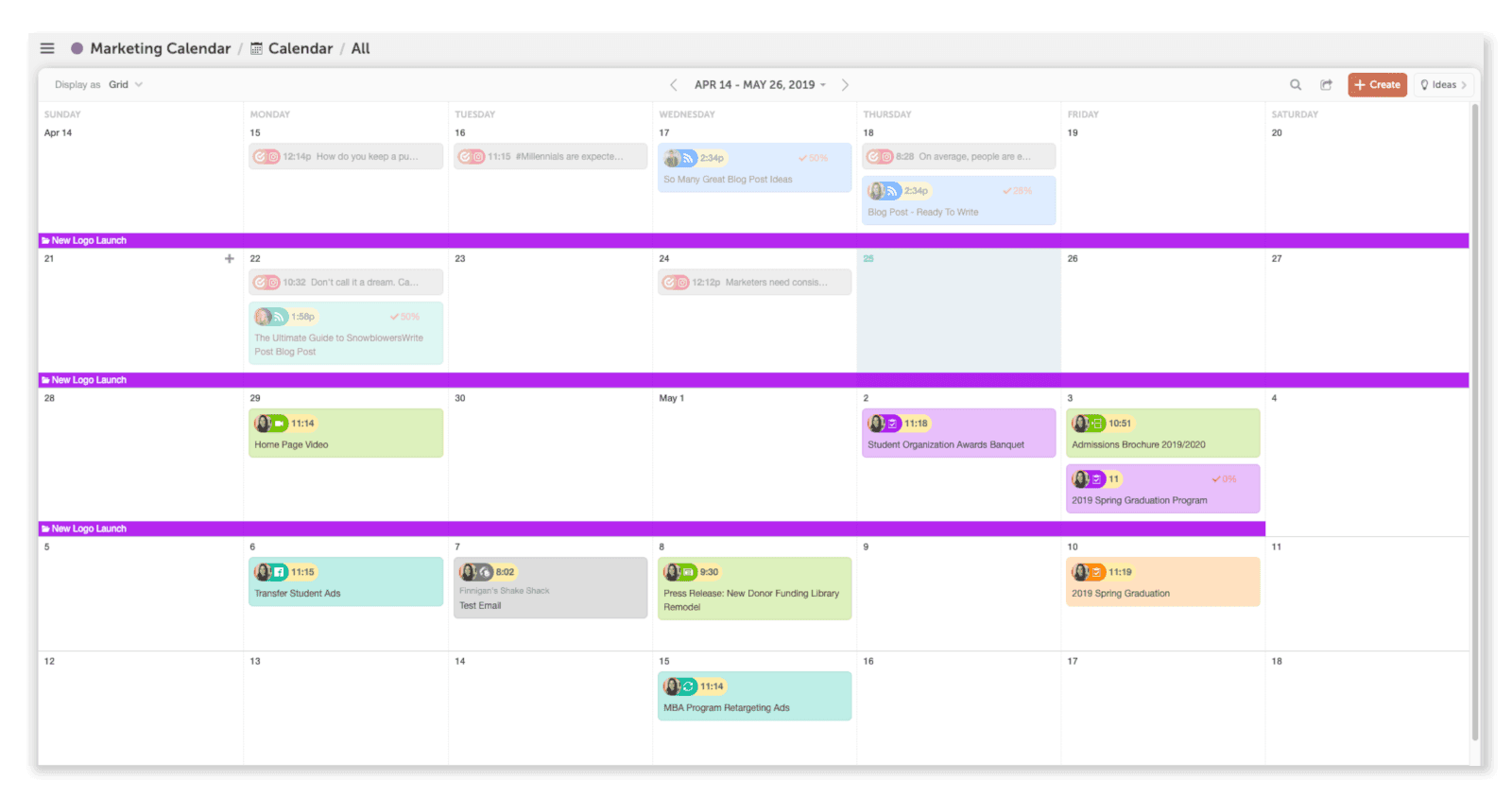 Some key benefits here include:
Some key benefits here include:
- Getting your strategy organized. Organized marketing teams are 397% more likely to report success (according to research data from CoSchedule).
- Avoiding last-minute fire drills. Instead of generating ideas on the fly, you can plan out exactly what you’ll be creating ahead of time.
- Giving your entire team full visibility. Collaboration becomes much easier when everyone can see what they’re responsible for and what’s being worked on. This is particularly true when managing multiple projects and campaigns at once.
Executing Your Strategy From Start to Finish
Once you have a plan in place, it’s time to put it into action. Use this mini-library of content from the CoSchedule Blog to dive deeper into any areas that are most relevant to your needs:- How to Create a Marketing Strategy That Will Skyrocket Your Results By 9,360%
- 30 Marketing Plan Samples and 7 Templates to Build Your Strategy
- How to Build a Content Marketing Strategy You’ll Actually Use
- How to Make a Video Marketing Strategy That Will Engage Your Audience
- The Best Way to Organize an Email Marketing Strategy
- The Best Way to Plan a Social Media Strategy in 5 Steps With a Template
- How to Boost a Marketing Workflow Process That Will Reduce Work By 30%-50%
- How to Implement an Effective Marketing Workflow Management Process in 7 Steps
- Marketing Workflow Management: How to Prevent Last-Minute Emergencies
- The Most Massive SEO Copywriting Guide That Will Make Your Traffic Soar
- The Best Social Media Copywriting Guide to Be a Social Word Ninja
- How to Write the Best Blog Posts That Will Grow Your Influence in 15 Steps
- 40 Content Writing Tips to Make You a Better Marketer Now
- The Email Copywriting Process You Need to Get More Conversions
- How to Design the Best Blog Graphics With Free Tools and Design Theory
- Making the Best Blog Graphics (For Non-Designers)
- Working With Designers (With Authentic Advice From CoSchedule’s Designer)
- Redesigning Your Website Like CoSchedule in 10+ Steps
- The Know-It-All Guide to Color Psychology in Marketing
Measuring Demand Generation the Right Way
If there’s anywhere that demand gen distinguishes itself from other general marketing practices, it’s in measurement. Sure, you can measure typical lead indicators like search engine rankings, traffic, and email signups (and you should keep an eye on these things). But, to truly understand if you’re generating demand, you need to look deeper and track how many qualified leads your content and campaigns are bringing in. This involves:- Knowing how to score leads. See the reading links below.
- Having the capability to track your leads. You’ll likely need a quality CRM tool to do this right (ex: Salesforce, etc.).
- Establishing a reporting cadence. Setting up a weekly, monthly, quarterly, and annual reporting schedule is beneficial.
- The Basic Science Behind Lead Scoring (Salesforce): Some useful theory that’s good to understand.
- Lead Scoring 101: How to Use Data to Calculate a Basic Lead Score (Hubspot): This is a great introduction to lead scoring to help you get started.
- The 10 Elements of an Effective Lead Scoring Model (AudienceOps): A framework for approaching lead scoring effectively.
Examples of Demand Generation in Action
So, what does an effective demand gen strategy look like when it’s actually put into practice? Here are some examples that show the tactical execution out in the real world.LinkedIn: Demand Gen Landing Page
Let’s start with an example from LinkedIn that’s all about doing demand gen with a landing about … well, demand gen. Try saying that five times fast. The first thing that brings readers to this page is the following Google PPC ad (the search that triggered this was “demand generation examples”): This takes you to the following page, touting LinkedIn’s effective as a platform for generating leads:
This takes you to the following page, touting LinkedIn’s effective as a platform for generating leads:
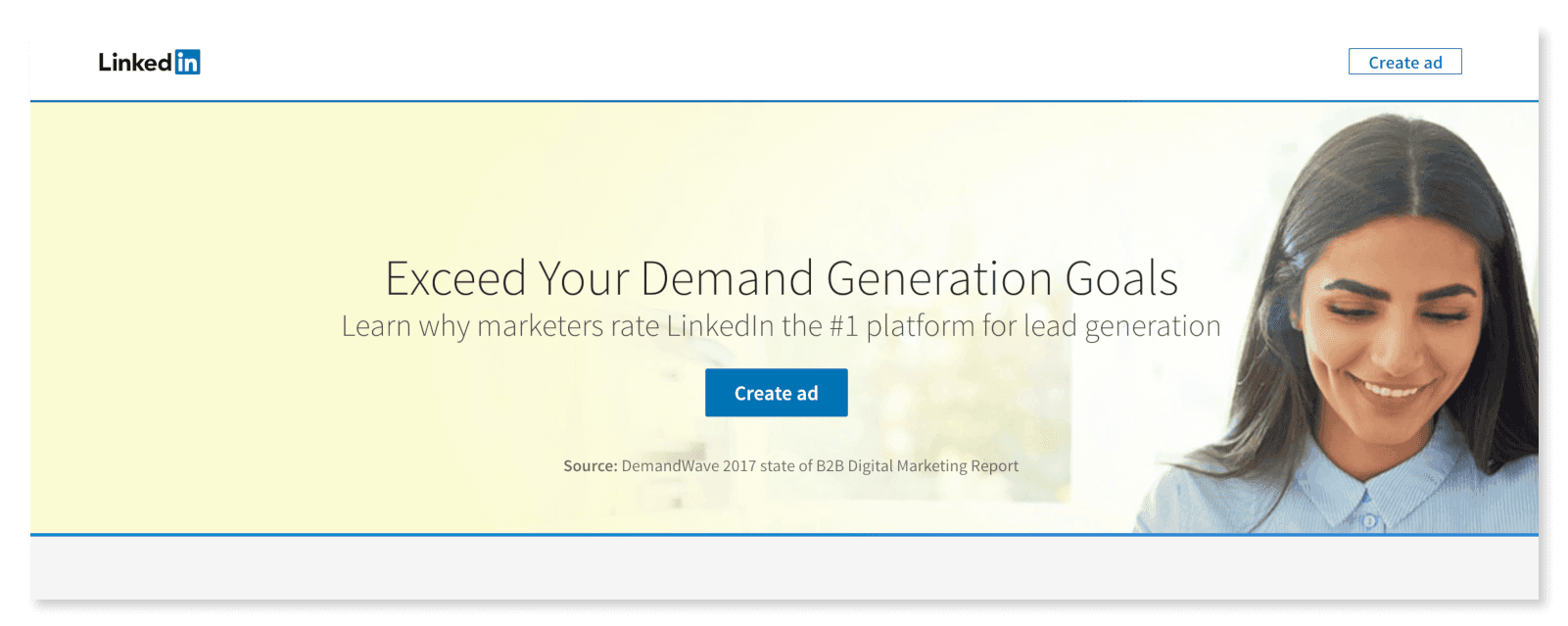 Scroll down a short way and the page does a nice job of building its case using statistics based on original research (a powerful tactic in itself):
Scroll down a short way and the page does a nice job of building its case using statistics based on original research (a powerful tactic in itself):
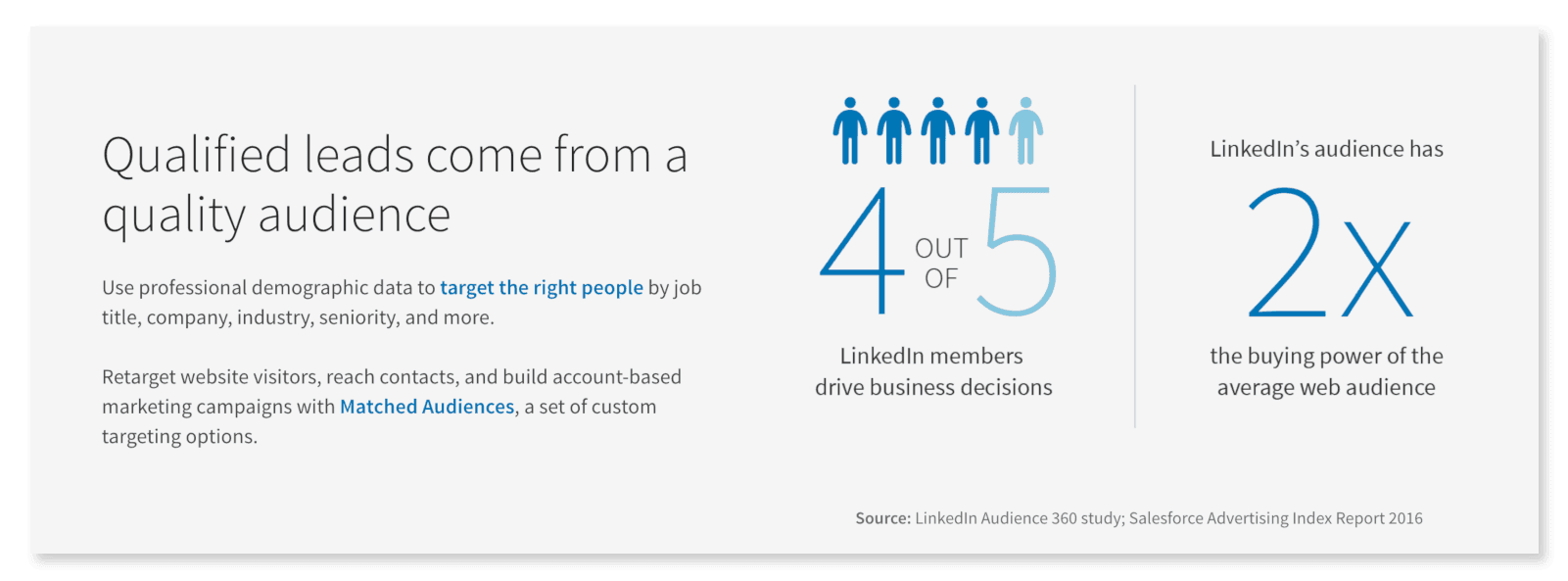 At the end, the call-to-action interestingly doesn’t ask for your information right away. Instead, after building the case for creating demand gen ads with LinkedIn, it invites you to try creating an ad yourself:
At the end, the call-to-action interestingly doesn’t ask for your information right away. Instead, after building the case for creating demand gen ads with LinkedIn, it invites you to try creating an ad yourself:
 Clicking the button takes you directly into the ads campaign manager in LinkedIn (once you’ve signed into your LinkedIn account):
Clicking the button takes you directly into the ads campaign manager in LinkedIn (once you’ve signed into your LinkedIn account):
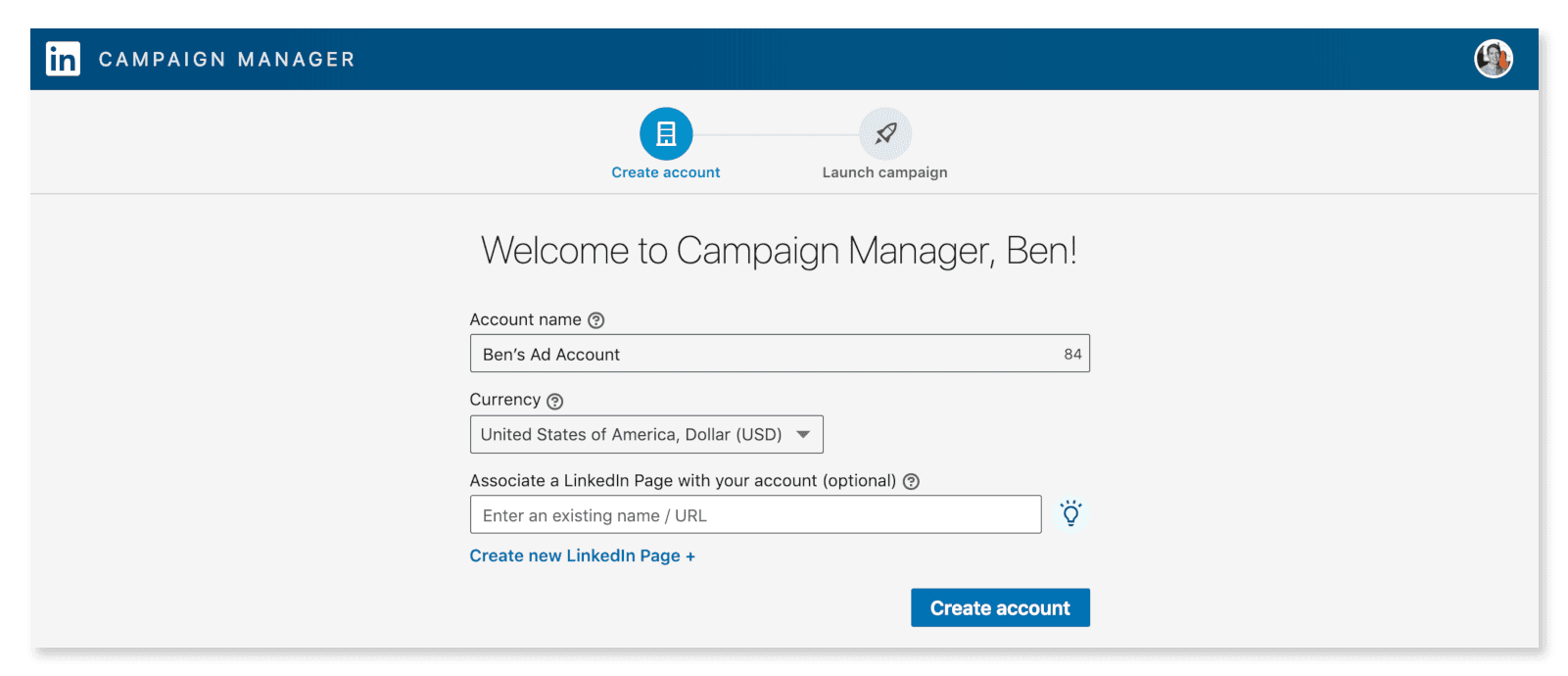 This is an extremely quick play at getting a direct response from your potential customer. But, what about another example that takes a more long-term strategy?
This is an extremely quick play at getting a direct response from your potential customer. But, what about another example that takes a more long-term strategy?
EventBrite: Downloadable Template Email
One way to build demand for services is to give people resources at no charge that helps them get started doing something themselves.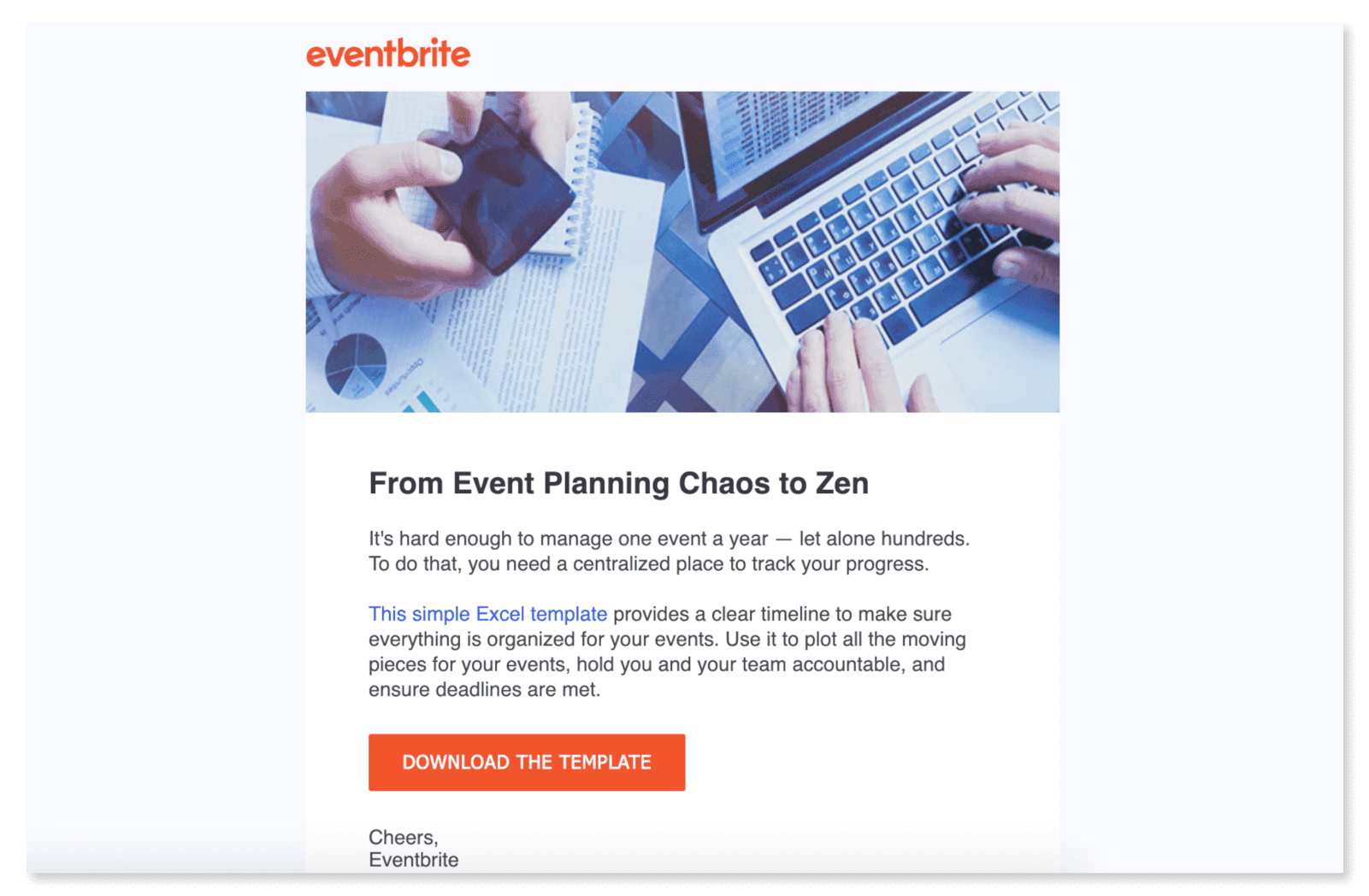 In this example, EventBrite sent out an email to their list offering a download for an event planning template. Ultimately, they want you to plan your events using their software, but the Excel spreadsheet can help you plan events more easily in conjunction with their product.
The copy in the email highlights a problem (the difficulty of tracking tons of events over the course of a year) and then wastes little time introducing a solution (that also happens to be directly tied into their product’s purpose).
If I’m already a customer, this is building goodwill by providing value. And if I’m not, I might wonder if now is the time to sign up, especially if I’m seeing this kind of value on an ongoing basis.
In this example, EventBrite sent out an email to their list offering a download for an event planning template. Ultimately, they want you to plan your events using their software, but the Excel spreadsheet can help you plan events more easily in conjunction with their product.
The copy in the email highlights a problem (the difficulty of tracking tons of events over the course of a year) and then wastes little time introducing a solution (that also happens to be directly tied into their product’s purpose).
If I’m already a customer, this is building goodwill by providing value. And if I’m not, I might wonder if now is the time to sign up, especially if I’m seeing this kind of value on an ongoing basis.
BuzzSumo: Slack Integration Announcement Email
Next, here’s an example of an email from BuzzSumo illustrating how demand gen can work when targeting existing customers: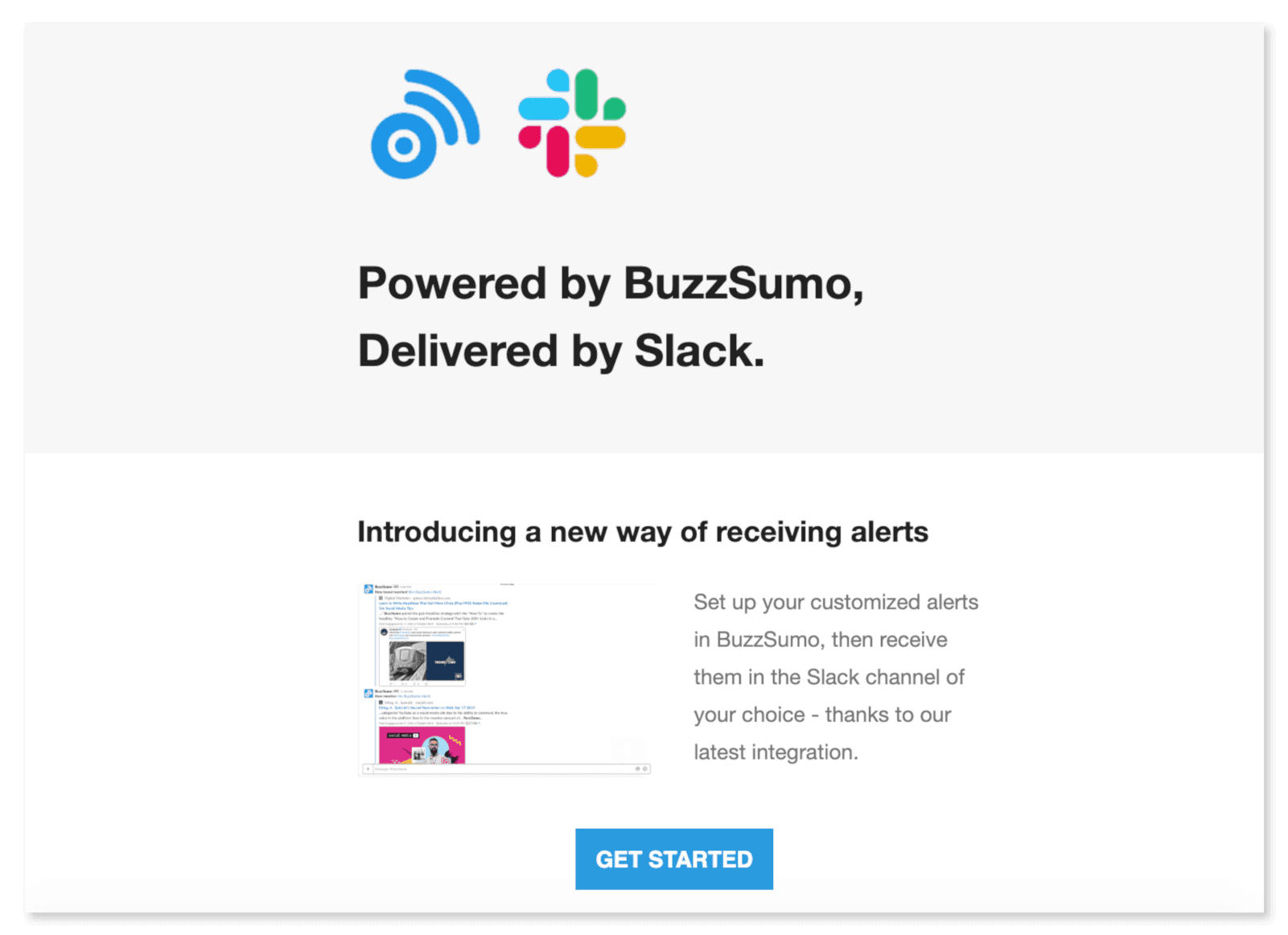
CoSchedule: Guide on Agile Marketing
Here’s another example, this time created by our team at CoSchedule. This is our guide on agile marketing, a multi-chapter that applies the topic cluster approach: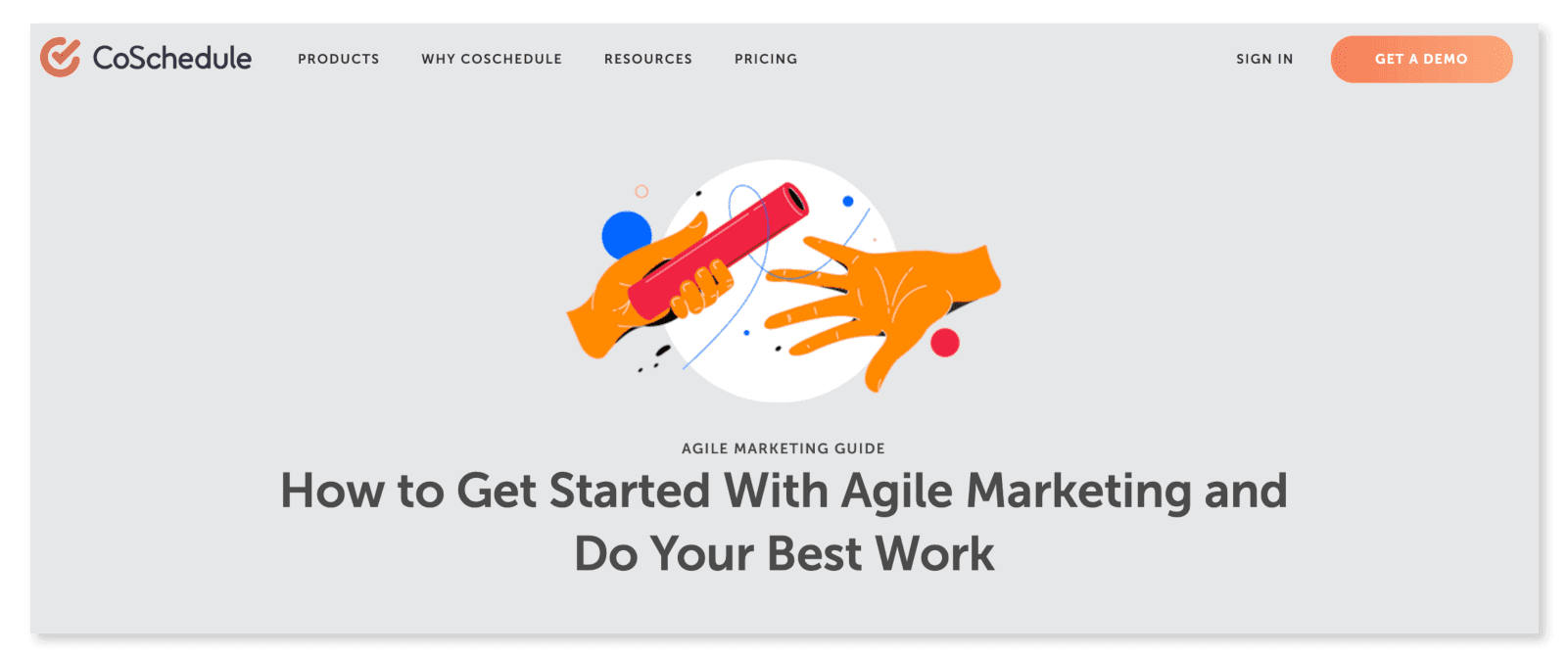 It lays out all the information around its topic using a clear navigational structure on the left:
It lays out all the information around its topic using a clear navigational structure on the left:
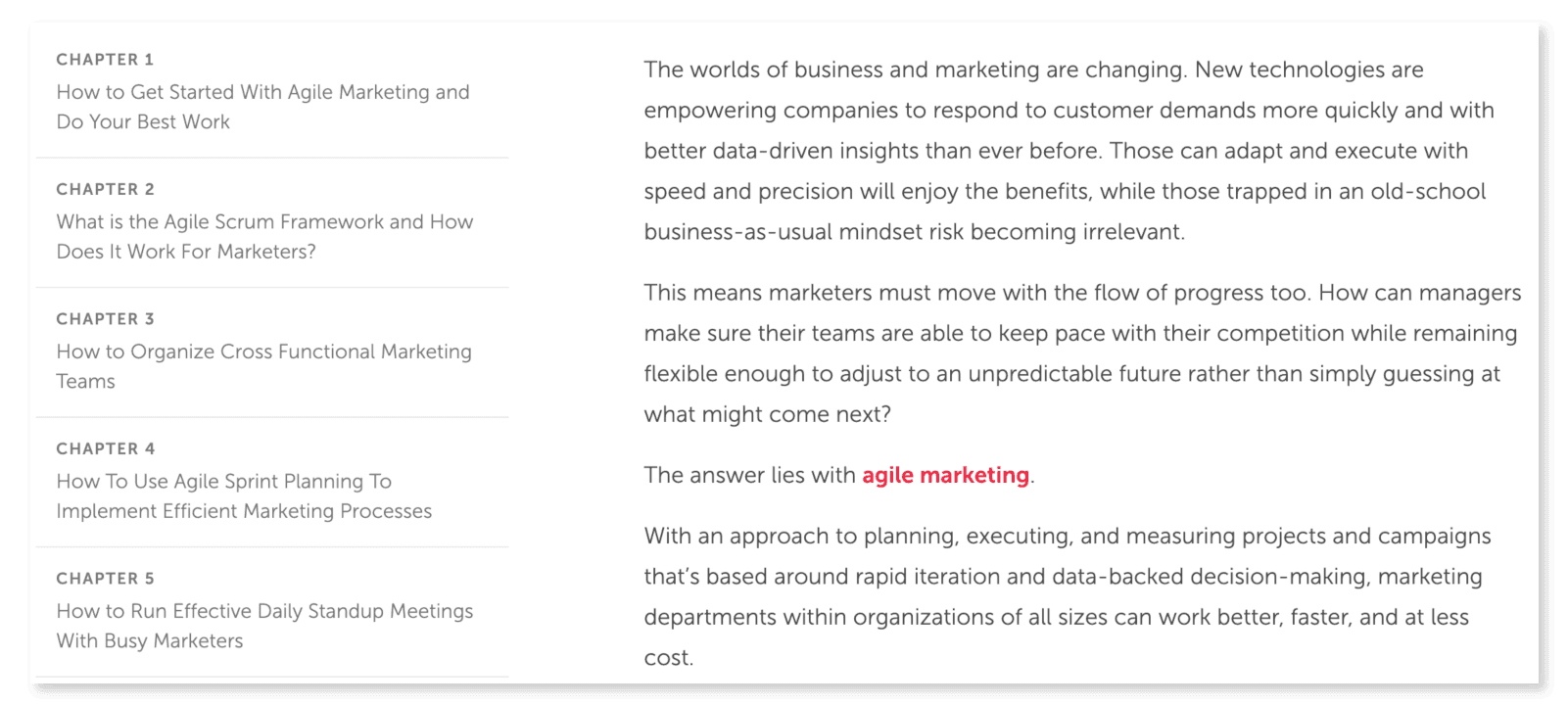 While all the information in the guide is freely available on the web, it also gives readers the option of downloading it as a PDF (while asking for an email address and company info for readers who aren’t already receiving email from CoSchedule):
While all the information in the guide is freely available on the web, it also gives readers the option of downloading it as a PDF (while asking for an email address and company info for readers who aren’t already receiving email from CoSchedule):
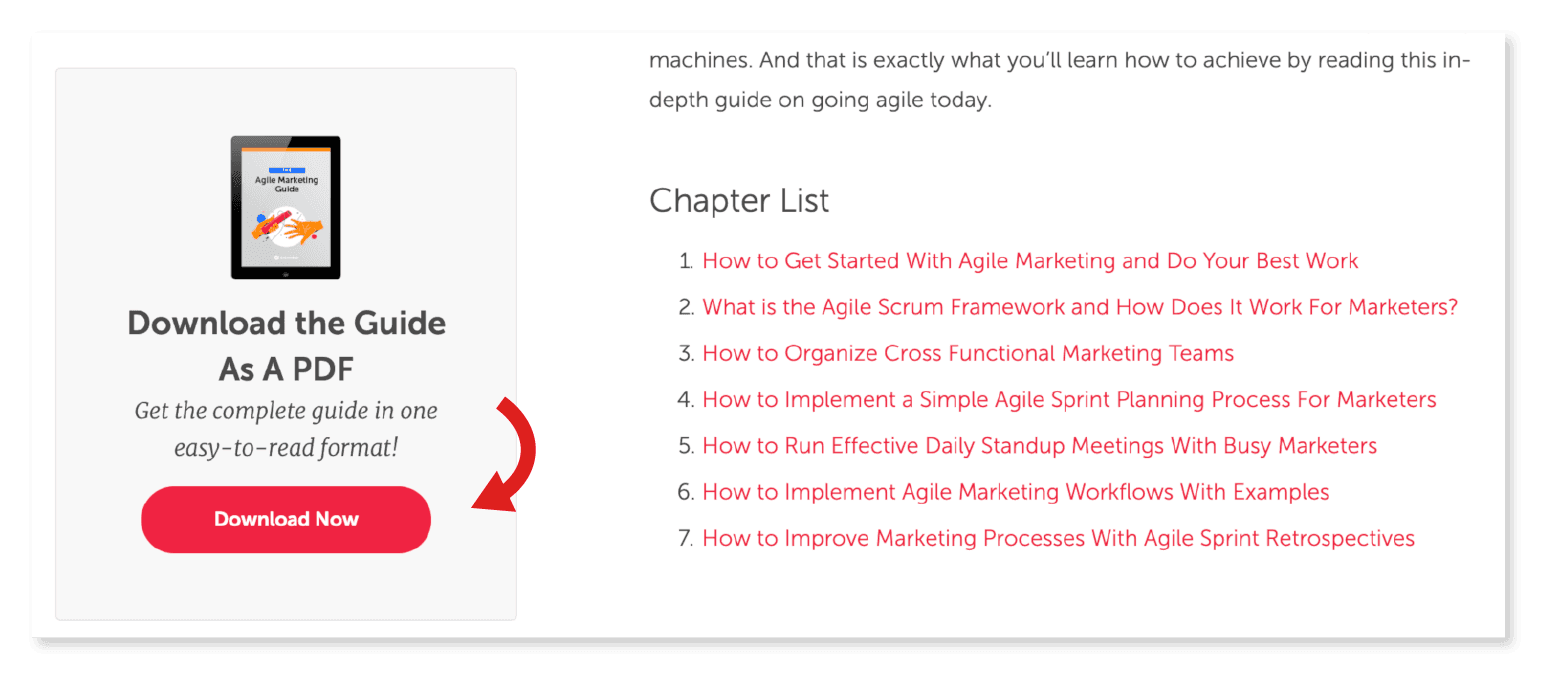
PedalTrain: PedalBoardPlanner.com
This next example comes from PedalTrain, a company that manufactures boards for securing effects pedals for guitarists. One issue with buying this particular product is knowing how many pedals you can fit on one board, especially since pedals don’t follow uniform sizing. So, they ingeniously built an interactive tool that lets you choose different PedalTrain models, and see how over 2,000 different popular pedals can be arranged to fit before you buy.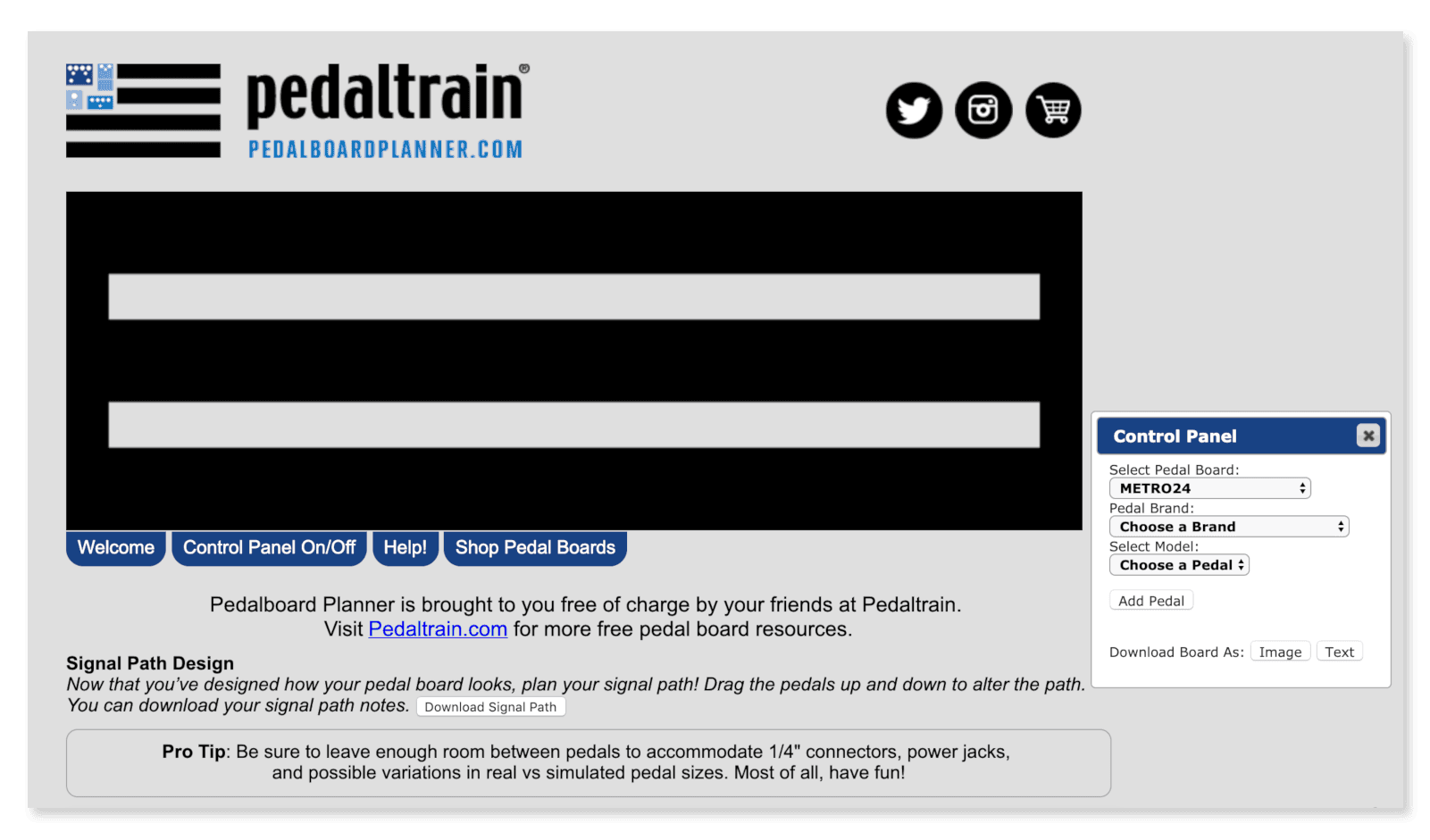 This helps build demand for PedalTrain’s products instead of their competitors since this is the only way to actually know you’re buying one that will fit what you need. It’s a unique tool that sets them apart from their competition
This helps build demand for PedalTrain’s products instead of their competitors since this is the only way to actually know you’re buying one that will fit what you need. It’s a unique tool that sets them apart from their competition
Stop Reading and Start Building More Business Now
Effectively executing a complete demand generation strategy takes time, patience, and hard work. But, equipped with everything you’ve learned in this post, you’re well on your way toward success. Keep this page bookmarked for reference, and best of luck with your efforts.


